|
Moderated by NW Okie! |
Volume 10 , Issue 302008Weekly eZine: (366 subscribers)Subscribe | Unsubscribe Using Desktop... |
WWII - Battle for the Ruhr

It was 1945, 31 March thru 15 April when the Battle for the Ruhr occurred. In the battle of Germany, no single portion bulks larger than the drive to neutralize the Ruhr. The Ruhr Valley was the most highly concentrated industrial area in Europe. With a pre-war population of more than four million, it produced eighty percent of Germany's coal, iron, and steel, and most of it chemicals and synthetic rubber. Its loss would prevent the Reich from long continuing the war.
"The task of eliminating the Ruhr fell to the Ninth Army's XVI Corps. Carrying out the Corps plan, the 75th Infantry Division, during the period 31 March - 15 April `1945, advanced east from the Rhine past the Dortmund-Ems Canal, then swung south and reached the Ruhr River, isolating Dortmund and contributing to the obliteration of the Ruhr pocket.
"The operation was carried out against formidable obstacles. The gravelly plateau on which the Division fought had numerous heavy forests, limiting fields of fire. It is interlaced by a system of canals averaging 10 feet in depth and 100 feet in width, with steep banks. it contained many villages, cities, and industrial plants, all capable of conversion into strong points, and furnishing over for snipers. it bristled with anti-aircraft weapons capable of use against ground targets. Finally, first class troops of the 116th Panzer, 180th, 190th and 2d Para Divisions were deployed in the area.
"To accomplish the division's mission called for the highest exertions of all arms. Basically, the job of seizing and holding was one for the Infantry. But both close and general support was constantly supplied by the artillery, augmented by additional battalions from corps; by the tanks and tank destroyers; and by the air support, which contributed numerous strikes. The engineers had to prepare canal crossings to make up for the more than 50 bridges blown by the retreating Germans. Because of the relative absence of any enemy air activity, the anti-aircraft battalion's normal mission was denied it; but it served, when needed, in the line as infantry.
"Enemy losses were severe. 3,54 enemy prisoners of war passed through the division's cage during the period 31 march - 15 April, and dead and wounded well exceeded this figure. Furthermore, many of the 14,173 prisoners of war taken through 16 April - 21 my 1945, during the division's occupational phase, had had the starch taken out of them in the Ruhr campaign. Enemy losses in material, particularly flak guns, anit-tank guns, tanks, self-propelled weapons, artillery, machine guns, mortars, trains and vehicles, were equally costly."
| View or Add Comments (0 Comments)
| Receive
updates ( subscribers) |
Unsubscribe
| © . Linda Mcgill Wagner - began © 1999 Contact Me | |
